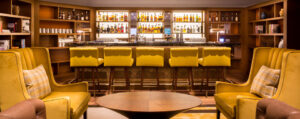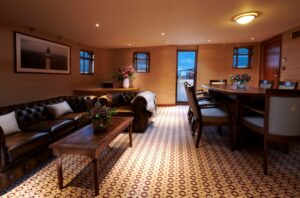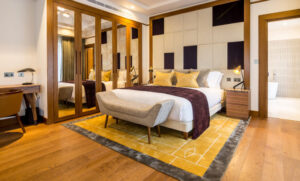In the realm of contract furniture design, every element contributes to the overall ambiance and functionality of a space. One such crucial element is color. The psychological impact of color on human emotions and behavior has been extensively studied, and its application in furniture design can profoundly influence the atmosphere of workspaces and environments. This article explores the role of color psychology in contract furniture, delving into its effects on mood, productivity, and creativity.
Understanding Color Psychology
Color Theory Basics
Before delving into the specifics of color psychology in contract furniture, it’s essential to understand the basics of color theory. Colors can be broadly categorized into warm tones (such as reds, oranges, and yellows) and cool tones (such as blues, greens, and purples). Each color carries its own psychological associations and can evoke different emotional responses.
Psychological Associations
- Red: Often associated with energy, passion, and intensity, red can stimulate the senses and increase alertness. However, it can also evoke feelings of aggression or provoke stress in some individuals.
- Blue: Symbolizing calmness, stability, and trustworthiness, blue is a popular choice for work environments where focus and concentration are paramount. It can promote a sense of tranquility and enhance productivity.
- Yellow: Representing optimism, happiness, and creativity, yellow can stimulate mental activity and foster a positive atmosphere. However, excessive use of yellow may lead to feelings of anxiety or distraction.
- Green: Associated with nature, growth, and harmony, green has a calming effect and promotes a sense of balance and well-being. It can also enhance creativity and innovation.
- Purple: Often associated with luxury, creativity, and spirituality, purple can add a sense of sophistication and elegance to a space. It can also stimulate imagination and inspire artistic expression.
Applications in Contract Furniture Design
Choosing Colors for Workspaces
When selecting colors for contract furniture in workspaces, designers must consider the specific needs and goals of the environment. For example:
- Productivity: In environments where productivity is key, such as offices and coworking spaces, blue and green hues are often preferred for their calming and focusing effects. These colors can help reduce stress and enhance concentration, leading to improved performance and efficiency.
- Creativity: For creative workspaces such as design studios or innovation labs, vibrant and stimulating colors like yellow and orange may be more appropriate. These colors can energize the mind and encourage brainstorming and ideation.
- Collaboration: In areas where collaboration and communication are essential, such as meeting rooms or collaborative workspaces, a combination of warm and cool tones can create a balanced and inviting atmosphere. Colors like purple and teal can foster teamwork and foster a sense of camaraderie among colleagues.
Incorporating Colors into Furniture Design
Once the desired color scheme has been determined, designers can incorporate these colors into contract furniture in various ways:
- Upholstery: The fabric or upholstery of chairs, sofas, and seating arrangements can be chosen in colors that align with the intended mood or atmosphere of the space. For example, vibrant red or orange upholstery can add a pop of energy to a breakout area, while muted blue or gray tones can create a sense of calm in a conference room.
- Finishes and Materials: The finishes and materials used in furniture construction, such as wood, metal, or laminate, can also contribute to the overall color palette of a space. Designers can select finishes that complement or contrast with the primary colors in the environment, creating visual interest and cohesion.
- Accessories and Accents: Small accessories and accents, such as throw pillows, rugs, or artwork, can be used to introduce accent colors and add depth to the design scheme. These elements can be easily changed or updated to reflect seasonal trends or evolving preferences.
Case Studies: Real-World Examples
To illustrate the practical application of color psychology in contract furniture design, let’s explore two case studies:
Case Study 1: Office Renovation Project
A multinational corporation undergoing an office renovation project sought to create a modern and inviting workspace that would promote collaboration and creativity among its employees. The design team incorporated a color scheme consisting of soft greens, blues, and neutrals, chosen for their calming and harmonious qualities. Contract furniture, including ergonomic task chairs, modular workstations, and collaborative seating areas, was selected in complementary hues to create a cohesive and visually appealing environment. The result was a revitalized workspace that not only enhanced employee morale and satisfaction but also improved overall productivity and teamwork.
Case Study 2: Coworking Space Design
A startup incubator and coworking space aimed to attract entrepreneurs and freelancers seeking a dynamic and inspiring work environment. The design team opted for a bold and eclectic color palette featuring vibrant yellows, oranges, and purples, intended to stimulate creativity and innovation. Contract furniture, including flexible seating arrangements, standing desks, and lounge areas, was chosen in complementary colors and styles to create a visually stimulating yet functional workspace. The result was a vibrant and energizing environment that encouraged collaboration, networking, and idea-sharing among members.
Conclusion
Color psychology plays a significant role in contract furniture design, influencing the mood, atmosphere, and functionality of workspaces and environments. By understanding the psychological associations of different colors and incorporating them thoughtfully into furniture selection and design, designers can create spaces that enhance productivity, creativity, and well-being. Whether it’s a calming blue office or a vibrant coworking space, the strategic use of color can transform a space into a dynamic and inspiring environment conducive to success.
Follow Us on Linkedin




